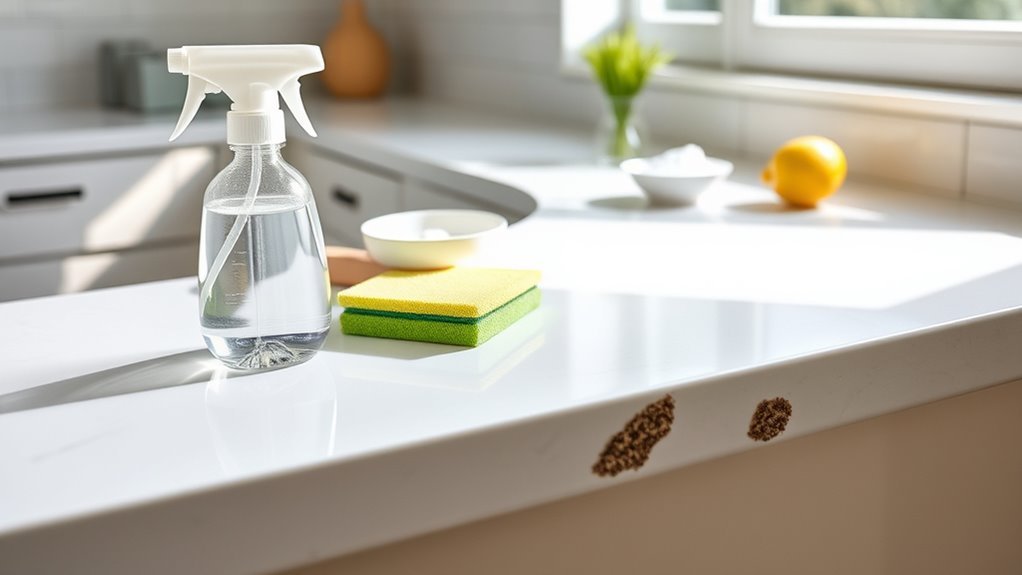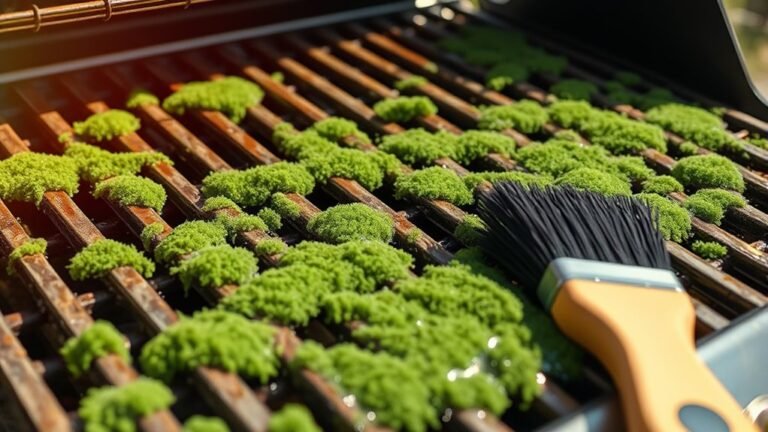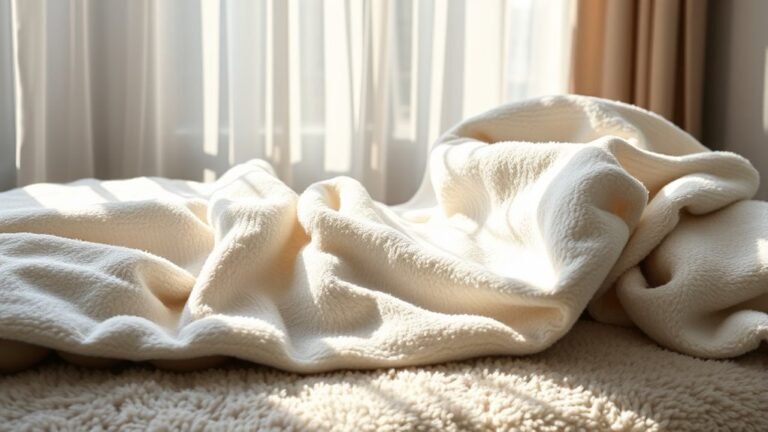How to Clean and Deodorize Your Mold
To clean and deodorize mold, first wear gloves, a mask, and goggles for safety. Identify moldy areas and prepare a cleaning solution like diluted bleach or white vinegar. Scrub affected surfaces thoroughly, rinse, and dry completely to prevent regrowth. Use baking soda or activated charcoal to help remove odors and improve air circulation by opening windows or using fans. Proper moisture control is key, and exploring deeper solutions can help you fully tackle mold and its smell.
Understanding the Causes of Mold Growth
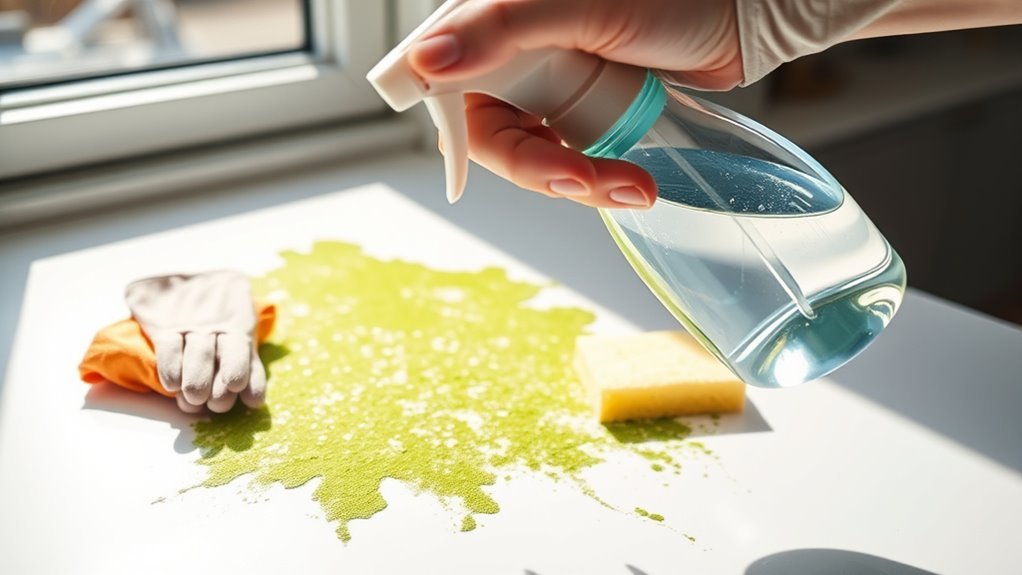
There are several key factors that contribute to mold growth, and understanding them can help you prevent it in your home. Mold thrives in damp, humid environments, so mastering moisture control methods is essential for keeping your space mold-free. You’ll want to address leaks, poor ventilation, and condensation promptly—these are common culprits that invite mold to settle in. Implementing mold prevention strategies like using dehumidifiers, fixing water damage quickly, and ensuring proper airflow can empower you to maintain a healthy, clean environment. By taking control of moisture, you’re not just stopping mold—you’re reclaiming your space and freedom from worry. Remember, preventing mold starts with understanding the conditions that allow it to grow and acting decisively to eliminate them.
Identifying Different Types of Mold in Your Home
You’ll want to recognize common household molds like black mold, white mold, and green mold, each with distinct appearances. Black mold often looks slimy and dark, while white mold appears powdery or fuzzy. Knowing these visual traits helps you spot mold early and tackle it effectively.
Common Household Mold Types
Although mold can appear in many forms, knowing how to identify the most common types in your home helps you tackle the problem effectively. Black mold, for example, often grows in damp areas like basements or bathrooms and can pose health risks if left unchecked. White mold, on the other hand, usually appears powdery and can thrive on surfaces like wood or drywall where moisture lingers. Both types can spread quickly if ignored, so spotting them early is key to maintaining a fresh, healthy environment. By recognizing these molds, you gain the freedom to act decisively—whether cleaning yourself or calling in help—ensuring your living space stays safe and comfortable without unnecessary delays or stress.
Visual Mold Characteristics
When you spot mold in your home, recognizing its visual traits can help you determine the best way to address it. Mold color and mold texture vary widely, giving you clues about the type and severity. Some molds are fuzzy, while others look slimy or powdery. Colors range from black and green to white and pink. Knowing these traits lets you act confidently and protect your space.
| Mold Color | Mold Texture | Common Locations |
|---|---|---|
| Black | Fuzzy | Bathrooms, basements |
| Green | Slimy | Walls, ceilings |
| White | Powdery | Windowsills, fabrics |
| Pink | Slimy | Shower curtains |
| Grey | Fuzzy | Air ducts, carpets |
Use this guide to identify mold quickly and decide your next move.
Essential Safety Precautions Before Cleaning Mold

Before you start cleaning mold, make sure you wear protective gear like gloves and a mask to keep yourself safe. Good ventilation is key, so open windows and use fans to improve airflow. Also, learn how to identify hazardous mold types to know when it’s best to call a professional.
Protective Gear Importance
Since mold spores can irritate your skin, eyes, and lungs, wearing proper protective gear is essential before you start cleaning. You don’t want to risk exposure that could cause discomfort or health issues. Grab gloves that resist chemicals, a mask rated for mold spores, and goggles to shield your eyes. Protective gear isn’t just a suggestion—it’s your first line of defense in cleaning safety. When you suit up correctly, you maintain control and freedom to tackle the mold without worry. Remember, skipping this step can lead to more problems than you bargained for, limiting your ability to clean efficiently. So, gear up smartly and protect yourself—it’s the key to cleaning mold safely and confidently.
Ventilation and Airflow
Wearing protective gear keeps you safe from mold spores on your skin and in your lungs, but controlling the air around you is just as important. Effective airflow management and humidity control free you from trapped spores and dampness that fuel mold growth. Before you start cleaning, make sure to:
- Open windows and doors to create cross-ventilation.
- Use fans strategically to push spores outside, not spread them indoors.
- Keep humidity levels below 60% with dehumidifiers or air conditioners.
- Seal off the affected area to prevent spores from traveling to other spaces.
Identifying Hazardous Mold
How can you tell if the mold you’re dealing with is hazardous? First, recognize that certain molds pose serious mold health risks, especially black mold or Stachybotrys chartarum. Identifying symptoms like persistent coughing, sneezing, headaches, or skin irritation after exposure can signal dangerous mold presence. If you or others experience respiratory issues or allergic reactions in the affected area, don’t ignore it. While some molds look harmless, it’s best not to take chances with your health or freedom to breathe clean air. Use protective gear and consider professional testing if you suspect hazardous mold. Knowing these signs empowers you to take control—safely clean or call experts—so you can reclaim your space without risking your well-being.
Choosing the Right Cleaning Supplies for Mold Removal
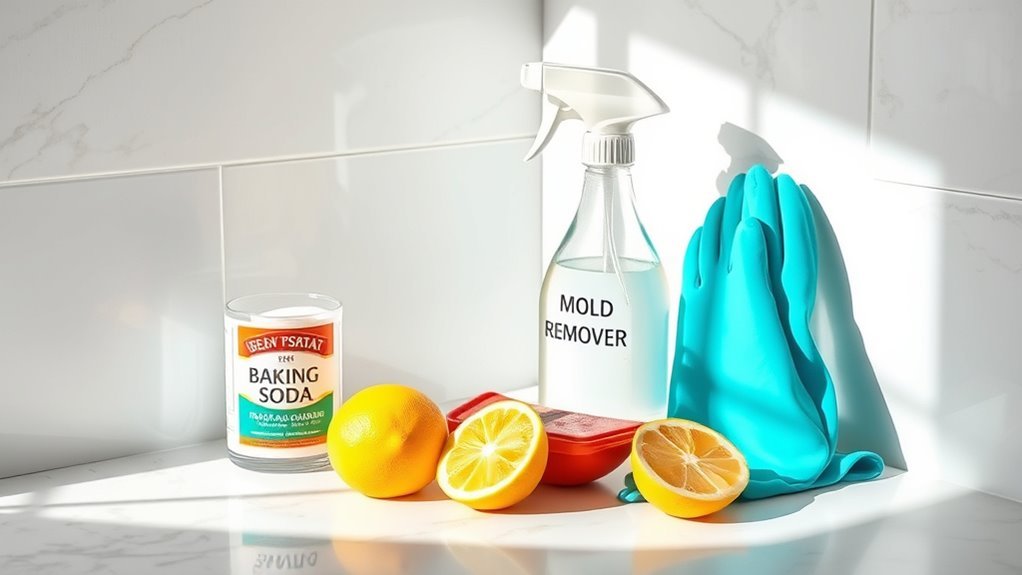
Before you start tackling mold, you’ll need to pick the right cleaning supplies to guarantee effective removal and prevent further growth. Choosing the best mold cleaning supplies guarantees you reclaim your space without lingering issues. Here’s what you should consider:
- Effective Cleaning Agents: Opt for products known to kill mold spores, like bleach solutions or commercial mold removers.
- Protective Gear: Gloves and masks shield you from harmful spores while maintaining your freedom to move safely.
- Scrubbing Tools: Brushes or sponges to physically remove mold from surfaces.
- Ventilation Aids: Fans or open windows help dry areas quickly, preventing mold’s return.
Selecting these essentials empowers you to fight mold efficiently and maintain a fresh, healthy environment.
Step-By-Step Guide to Cleaning Mold From Surfaces
First, you’ll need to identify all the moldy areas to guarantee none are missed. Next, prepare your cleaning solution based on the supplies you’ve chosen. Finally, scrub the affected surfaces thoroughly and rinse them well to remove mold and residue.
Identify Moldy Areas
Mold often hides in damp, poorly ventilated spots like bathrooms, basements, and around leaky pipes. To regain control of your space, start by using proven mold identification techniques. Visual cues like discoloration or fuzzy patches are your first hint. You can also employ mold detection tools—like moisture meters or UV flashlights—to uncover less obvious infestations. Here’s a quick guide:
- Inspect common moisture-prone areas thoroughly.
- Use mold detection tools to confirm hidden growth.
- Note any musty odors, a classic sign of mold presence.
- Mark affected spots clearly to plan your cleaning.
Prepare Cleaning Solution
To tackle mold effectively, you’ll need a reliable cleaning solution tailored to the surface you’re treating. Different materials call for specific cleaning agents and solution ratios to guarantee mold removal without damage. Here’s a quick guide to mixing your cleaning solutions:
| Surface Type | Cleaning Agent | Solution Ratio (Agent:Water) |
|---|---|---|
| Hard Surfaces | White Vinegar | 1:1 |
| Fabric | Baking Soda Solution | 1 tbsp baking soda: 1 cup water |
| Wood | Hydrogen Peroxide | 1:2 |
Always mix fresh solutions and wear gloves for safety. This approach gives you freedom from mold without harsh chemicals, protecting your space and health.
Scrub and Rinse Surfaces
Grab a scrub brush or sponge and apply your cleaning solution generously to the affected area. Different surface materials require specific cleaning techniques, so adjust your approach accordingly to protect your space and freedom.
- Start scrubbing firmly but gently to avoid damaging delicate surfaces.
- Focus on stubborn mold patches, ensuring you cover all visible spots.
- Rinse the area thoroughly with clean water to wash away mold and solution residue.
- Dry the surface completely to prevent mold from returning.
Natural Remedies for Mold Removal and Deodorizing
Although commercial cleaners can be effective, you might prefer natural remedies that are safer for your home and health. Start by mixing a vinegar solution—equal parts white vinegar and water—in a spray bottle. Spray the affected area generously, let it sit for an hour, then scrub with a brush. Vinegar naturally kills most mold types without harsh chemicals. For extra deodorizing power, sprinkle baking soda over the damp surface after the vinegar treatment. Baking soda neutralizes odors and absorbs moisture, preventing mold’s return. After scrubbing again, rinse with water and dry thoroughly. These simple, natural ingredients give you freedom from toxins while effectively clearing mold and odors. You’ll enjoy a fresher, healthier space without compromising your values or safety.
Using Commercial Products to Eliminate Mold and Odors
If natural remedies don’t fully tackle the mold or you need faster results, commercial products can offer powerful solutions. These specially formulated agents target mold cleaning and odor elimination efficiently, freeing you from stubborn infestations.
Here’s how to use them wisely:
- Choose products labeled for mold removal and odor control to guarantee effectiveness.
- Follow instructions precisely—overuse won’t speed things up and might cause damage.
- Wear protective gear to safeguard your health during application.
- Test on a small area first to avoid discoloration or surface damage.
Preventing Mold Recurrence With Proper Ventilation
Since mold thrives in damp, stagnant air, ensuring proper ventilation is key to keeping it from coming back. You can take control of your space by adopting smart ventilation strategies that promote airflow and reduce moisture buildup—two essential elements for effective mold prevention. Open windows regularly, use exhaust fans in kitchens and bathrooms, and consider installing vents or dehumidifiers where humidity tends to linger. These simple steps help you maintain a dry environment where mold struggles to grow. Remember, consistent airflow is your ally in breaking mold’s cycle, giving you the freedom to live comfortably without worrying about recurring mold problems. By prioritizing ventilation, you create a healthier home and keep your space fresh and mold-free for good.
Deodorizing Techniques to Remove Musty Smells
When mold leaves behind that stubborn musty smell, tackling the odor directly is just as important as cleaning the source. You can reclaim fresh air with these deodorizing techniques:
- Sprinkle baking soda on carpets or upholstery, let it sit for hours, then vacuum to absorb odors naturally.
- Use white vinegar in a spray bottle to mist affected areas; its acidity neutralizes musty smells without harsh chemicals.
- Place bowls of baking soda or activated charcoal around the room to continuously absorb lingering odors.
- Open windows and use fans to circulate fresh air, helping to dispel trapped moisture and odors.
When to Call a Professional for Mold Remediation
Dealing with mold odors can be handled with household remedies, but some situations require expert help. If the mold covers a large area or keeps returning despite your efforts, it’s time to reflect on professional mold inspection services. These experts can identify hidden mold sources and assess the extent of contamination, helping you avoid health risks and property damage. While remediation costs might seem intimidating, professional removal guarantees thorough cleanup, preventing costly repairs later. You shouldn’t compromise your freedom or well-being by ignoring persistent mold problems. Calling in professionals frees you from ongoing worries and lets you enjoy a safe, fresh space. When mold becomes overwhelming or hazardous, trusting specialists is the smartest move toward reclaiming your home.
Frequently Asked Questions
Can Mold Exposure Affect My Pets’ Health?
Yes, mold exposure can definitely affect your pets’ health. Just like humans, pets can show mold symptoms such as coughing, sneezing, watery eyes, or skin irritation. For your pet’s safety, it’s essential to keep their environment mold-free so they can enjoy their freedom without health worries. If you notice any unusual symptoms, consider checking for mold and consulting your vet to keep your furry friends safe and happy.
How Does Humidity Level Influence Mold Growth?
You’ll want to pay close attention to humidity levels because high humidity creates the perfect environment for mold to thrive. Maintaining proper humidity control is key to mold prevention, especially in places like basements or bathrooms. When the air’s too moist, mold spores multiply faster, limiting your freedom to enjoy a clean, healthy space. By keeping humidity below 60%, you’re taking a powerful step toward preventing mold growth and protecting your home.
Are Certain Houseplants Effective at Reducing Mold Spores?
You might think houseplants are like little superheroes, swooping in to save your home from mold spores! While certain plant types, like spider plants and peace lilies, do help with air purification, they’re no magic cure-all. They can reduce airborne mold spores a bit but won’t eliminate mold problems entirely. If you want true freedom from mold, you’ll need to tackle humidity and cleanliness along with your green allies.
Does Mold Impact Indoor Air Quality Tests?
When you’re dealing with mold testing, it’s important to know that mold can definitely impact indoor air quality results. Mold spores released into the air can skew your air quality tests, making it harder to get a true picture of your environment. If you want the freedom to breathe easy, you’ll want to address any mold issues before testing so your results reflect the real air quality, not just hidden mold problems.
Can Paint or Wallpaper Hide Mold Problems?
You might think covering mold with paint or wallpaper is like slapping a bandage on a roaring wildfire—it’s not going to solve the root issue. Hiding mold growth only delays mold detection and lets the hidden growth spread, risking your freedom from health problems. Instead of masking the problem, you should address the source directly. Otherwise, you’re just trapping the mold, making it harder to breathe freely in your own space.
